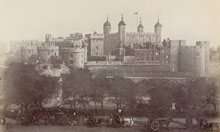|
Norman London
By Margaret Johnson
After his victory at the Battle of Hastings, William the Conqueror 's army ravaged much of the country in
order to beat the English into submission. Though
he burnt Southwark, he strategically avoided
London and waited at Berkhamsted for the city's
officials to recognise him as King. The Londoners
quickly acquiesced and their swift action led the
new monarch to grant their city the first formal
charter of his reign. This slight parchment
document is undated but it would appear that it
was made at Berkhamsted and only ratified later
in London itself. In the late 1920s, A.H. Thomas,
then Clerk of the Records at Guildhall,
successfully identified a wax seal from the
document as having been the second Great Seal
used by King William. The charter shows
remarkable generosity:
William,
King, greets William, Bishop, and Gosfregdh,
Portreeve, and all the burgesses within London,
French and English, friendly. And I give you to
know that I will that ye be all those laws worthy
that ye were in King Edward's day. And I will
that every child be his father's heir after his
father's day, and I will not suffer that any man
offer you any wrong. God help you.
This
exceptional status of London, which was
answerable only to the King and enjoyed his full
protection, was a strong influence in making it
the outstanding commercial centre of the time.
Its government was both secular, under the
portreeve, and ecclesiastical, under the bishop.
There were no new powers granted and the freedoms
of the citizens, which had been enjoyed in
previous years, were now enshrined in law.
These laws were based upon the
older Anglo-Saxon laws and made London equal to
the shires, having rights beyond its physical
boundaries. The assembly, or folkmoot, had
very early roots and had long decided matters of

Tower of London and Tower Bridge Walking Tour
You will enjoy following the Tower of London Beefeaters as they conduct the official daily opening ceremony and then enter the Tower of London fortifications to view the Crown Jewels before the huge crowds arrive. See spectacular highlights of the White Tower as well as the famous Beefeaters and other areas of this remarkable Tower that has stood along the banks of the Thames for over 1,000 years. And that's not all; afterwards our local, expert guide will lead a fascinating walking tour of the Tower Bridge, complete with tales that make history come alive. With our prepaid admission tickets for London Bridge included in the tour, guests will enjoy unforgettable views of London's iconic landmarks as well as visit one of the favorite spots in this part of London to take the best picture memory of the City of London.
|
|
importance to the community. There is evidence
that a sheriff oversaw the Hustings of
London, not unlike a shire court. It would have
dealt with work which was beyond the scope of the
folkmoot and has left traces in the
English legal system of today. The sheriff
himself was the natural Norman development of the
Saxon portreeve and was a very powerful
man.
The King built the Tower of
London at the watergate on the western edge of
the city wall, not only to observe and intimidate
the most important city in his new realm, but
also to protect it. A second castle, Baynard's
Castle, was erected by Ralph Baynard in the east,
with a moated keep, Monfichet Tower, nearby.
Though London is not mentioned in the Domesday
Survey of 1086, we know that its population of
both Normans and Saxons was growing fast. The
charter and the new-found stability served to
increase both trade and numbers as livelihoods
became secure once more. This happy situation
remained to the end of William's reign.
His successor, William Rufus , showed less regard for the people of
London. He is notable for his building works: the
great hall at Westminster, reinforcement of the
Tower of London and rebuilding the Thames bridge
which had been seriously damaged by flooding. In
1087, the city was devastated by a great fire and
St. Paul's was burnt to the ground (though it was
soon rebuilt).
The election of Henry I was very popular in London and he was
later to grant the city folk an exceptional
charter of liberties. This was fully implemented
under King John who, being overcome by civil unrest,
was obliged to appease his citizens by
introducing these new civil rights. The county of
Middlesex was given to London, with the right to
appoint a sheriff (shire-reeve). The other shires
were overseen by a royal officer, chosen directly
by the King, who would ensure that all fiscal and
military matters were efficiently managed within
his region. London's relative freedom was unique
within the country.
This pre-eminence was to be
tested further when, in 1135, on the death of the
king, Stephen made a claim on the English throne. The
Londoners claimed the right to elect their new
king and decided to support him. When, later,
Stephen was held prisoner following the Battle of
Lincoln, the people of London demanded the return
of their monarch and its forces were eventually
instrumental in banishing his rival, Matilda , from the kingdom.
Next: Medieval
London
|
© 2016 offtolondon.com All rights reserved.
Contact Us |
|
|
| |